As I Was Saying is a forum for a variety of perspectives to foster faith-related conversations among our readers with the goal of mutual learning, even in disagreement. Apart from articles written by editorial staff, these perspectives do not necessarily reflect the views of The Banner.
With the spike in new drive-in church services amidst the spread of COVID-19, will they stay with us long after the demand for social distancing ends?
Even a few months ago, predicting the rise of drive-in churches was laughable. But this past Easter and Mother’s Day weekends, drive-in worship became a Covid-19 trend—along with Tiger King, baking bread, and not wearing pants for Zoom meetings. From South Carolina to Wisconsin to Texas to Utah to California, drive-in worship has become a hot option for socially distanced worship. Even Robert A. Schuller, the son of pastor and televangelist Robert H. Schuller, revisited his father’s legacy by promoting a drive-in service just a few miles from where the innovative idea took off.
Well before the successes of the globally televised Hour of Power and the architectural triumph of the Crystal Cathedral, the elder Schuller started his influential Southern California ministry in 1955 at the Orange Drive-In Theater. Schuller had not planned to host worship services at the drive-in. But by the time he arrived in Orange County, the Baptists, Methodists, and Presbyterians had taken every other available meeting place. These early pioneers rented out spaces of every size, including movie houses and funeral homes, to establish their emerging congregations. Out of options, Schuller resigned himself to his suburban context, climbing atop a snack bar and preaching to a congregation assembled for worship in “pews from Detroit.”
With clever marketing and a mobile audience already trained to attend church every Sunday, Schuller found success with this unexpected format. He eventually reinterpreted his drive-in church not as a last resort, but as an innovative form of accessible worship. Everything could be modified for in-car worship: even communion and infant baptism were conducted through rolled-down windows. Southerners and Midwesterners lacking social connections found an option that required no prior relationships and no real commitment. The comfort of the car, the lack of judgment for dressing casually, the ability to keep families together, and the ease of entry and exit proved a winning combination.
Schuller stumbled on a means to allow strangers to attend church. The real discovery was finding a way for migrants to easily attend church without the need to “know” someone, finding a church connection through a neighbor or friend. He keenly intuited popular principles for stimulating church growth: easy parking, easy seating, an easy message to absorb, and an easy mechanism for giving.
Leveraging his local success into national influence, Schuller aggressively promoted drive-in churches as the future of American Christianity. He distributed promotional materials widely that mapped out nationally franchised congregations across America. Church leaders outside of sunny Southern California asked, “What about rain and snow?” Schuller confidently answered that churches would assemble under climate-controlled domes in regions with less accommodating weather.
Dozens of churches followed his call. With Schuller as their exemplar, spaces opened across the continent. Schuller himself continued a drive-in option throughout his 50-year ministry. The minister would eventually merge his drive-in worship service with a traditional walk-in sanctuary so successfully that he parlayed it all into the $20 million Crystal Cathedral—dedicated in 1980 with 80-foot “Cape Canaveral” doors that swung open to include parking lot worshipers.
Drive-in church, though, proved to be a fad. Even Schuller realized that auto-centric worship had its limits: it required too much property, and without dedicated meeting rooms, it limited the scope of ministry.
Will it endure? Probably only as long as we have to practice social distancing. The notion of drive-in churches had rested as a memory of a bygone era. Quite suddenly, though, the notion of in-car worship became a normalized innovation—born out of desperation more than convenience. Church leaders will quickly experience the nuisances of heat, rain, and parking lot limits. Volunteers will be more difficult to recruit, and giving is not likely to rise to the levels seen with the full experience of in-building worship—while pastors can still suggest online withdrawals, you can’t pass a plate (even through open car windows) during a pandemic. In short, the consequences of drive-in church will limit the popularity of drive-in church once the pandemic passes.
The bottom line is this: As bars, restaurants, and movie theaters reopen, so will walk-in churches.
About the Authors
Mark T. Mulder is professor of sociology at Calvin University in Grand Rapids, Mich. He and his family are members of Sherman Street CRC.
Gerardo Martí is L. Richardson King professor of sociology at Davidson College in Davidson, N.C. Mulder and Martí are co-authors of The Glass Church: Robert H. Schuller, the Crystal Cathedral and the Strain of Megachurch Ministry.

